Assessment of the Impact of CO, NOx and PM10 on Air Quality during Road Construction and Operation Phases
Abstract
:1. Introduction
2. Materials and Methods
- Definition of the study site
- Data collection on construction plan (construction sites, construction activities, duration of activities, equipment, and plants), motorway features (configuration, traffic flows), topography, and meteorology
- Calculation of emissions in construction and operation phases
- Modeling of critical pollutant dispersion in operation phase
- Comparison of impact on air quality in the two phases.
2.1. Study Site
2.2. Data Collection
- Relevant characteristics (position, extension, function) of 25 work areas distinguished in construction sites (CS), in which the storage of materials and the production of the concrete and the elements for tunnels lining take place, and in technical areas (TA), where all equipment and plants needed for construction of bridges and tunnels are located.
- The type of off-road machines and the equipment used in each worksite (see Table 1). The number and type of equipment depend on the construction activities taking place in the worksite.
- The duration of construction of the motorway: 8 years.
- The traffic data. During operation, the amount of emissions depends mainly on the number and type of vehicles circulating. The motorway under examination, which has a length of 18 km, can be subdivided in two sections for the presence of two interchanges located at 4.5 km from the beginning and at the end. The day and night peak hour flow (maximum hourly flow during the day time is 6:00 a.m.–10:00 p.m. and night time is 10:00 p.m.–6:00 a.m.) and the percentage of heavy traffic (vehicle weight more than 3 tons) for the two sections are reported in Table 2.
- The data on the actual air quality gathered at five monitoring points along the site of the future motorway.
2.3. Modelling of Pollutants Emission
- Topsoil excavation
- Storage
- Transits of trucks on unpaved road
- Crushing of aggregates.
- the emissions are referred to in the 2015 Italian fleet, consisting of 39.7% of diesel and 60.3% of gasoline vehicles
- the emissions are estimated considering the 2030 as reference year. According to PIARC [36], corrective factors are adopted in forecasting the future emissions. These factors consider that vehicle legislation has enforced more stringent emission rates and that vehicle technology has rapidly advanced, resulting in lower emissions.
- Perfectly blended phase
- Steady-state conditions over the time of incoming and outgoing air in the tunnel
- Stationary traffic flow
- Stationary emission flow
- Absence of abatement phenomena
- Uniform concentration within the tunnel determined by the phenomena of turbulence.
- C is the concentration inside the tunnel [g/h]
- C0 is the inlet concentration
- uwind is the constant incoming wind speed [m/s]
- W is the tunnel height [m]
- L is the tunnel length [m]
- Q is the emission of pollutant [g/s]
- q is the emission of pollutant per unit of surface = Q/Aemiss [g/s mq]
- Aemiss = W × L is the area of the emissive source [mq]
- Estimate of the emission inside the tunnel taking into account its average length and the traffic;
- Definition of a virtual point source at the tunnel portal, diameter 6 m, height equal to half of the height of the tunnel, speed 1 m/s and temperature equal to 15 °C, at which is assigned the emission of the entire tunnel section.
2.4. Modelling of CO Dispersion
3. Conclusions
- The rate of CO and NOx pollutants released during both phases, construction and operation, are comparable, while the emissions of PM10 are lower. However, PM10 is a significant pollutant in the construction phase, being one order of magnitude higher than in operational phase.
- PM10 in the construction phase originated in a percentage of 85% by storage, transit on unpaved road, and aggregate crushing, and in little part (15%) by the exhaust gases emissions of equipment and trucks.
- In operation, the portals of the tunnel, throughout which exit all the emissions produced inside the tunnel, are the main hotspots of the motorway. The pollutant concentrations in these points are four times higher than the maximum values estimated in the construction for CO and NOx. Except these points, in most cases, the average emissions of CO and NOx in construction is higher than the ones in the operation phase.
- As a consequence of these findings, in road construction, an accurate estimate of air emissions appears essential, as well as the constant monitoring aimed at the comparison of the estimated theoretical values from the equations and the measured ones and the implementation of proper mitigation measures, which can be eventually further tailored based on the monitoring outcomes. The attention to the construction phase should be higher, especially for the roads that require activities’ duration to be significantly higher for the presence of demanding components, tunnels and bridges.
- The most emissive activities in construction and the tunnel portals in motorway operation are the hotspots, to which the greatest attention must be directed in order to achieve objectives of sustainability in road transportation.
Funding
Conflicts of Interest
References
- Iarocci, G.; Andrea Cocchiara, R.A.; Sestili, C.; Del Cimmuto, A.; La Torre, G. Variation of atmospheric emissions within the road transport sector in Italy between 1990 and 2016. Sci. Total Environ. 2019, 692, 1276–1281. [Google Scholar] [CrossRef] [PubMed]
- Hime, N.J.; Marks, G.B.; Cowie, C.T. A Comparison of the Health Effects of Ambient Particulate Matter Air Pollution from Five Emission Sources. Int. J. Environ. Res. Public Health 2018, 15, 1206. [Google Scholar] [CrossRef] [PubMed] [Green Version]
- Kim, K.H.; Kabir, E.; Kabir, S.A. Review on the human health impact of airborne particulate matter. Environ. Int. 2015, 74, 136–143. [Google Scholar] [CrossRef] [PubMed]
- Paril, V.; Tothov, D. Assessment of the burden on population due to transport-related air pollution: The Czech core motorway network. J. Clean. Prod. 2020, 275, 123111. [Google Scholar] [CrossRef]
- Brook, R.D.; Rajagopalan, S.; Pope, C.A., 3rd; Brook, J.R.; Bhatnagar, A.; Diez-Roux, A.V.; Kaufman, J.D. Particulate matter air pollution and cardiovascular disease: An update to the scientific statement from the American Heart Association. Circulation 2010, 121, 2331–2378. [Google Scholar] [CrossRef] [PubMed] [Green Version]
- Fuks, K.B.; Weinmayr, G.; Basagana, X.; Gruzieva, O.; Hampel, R.; Oftedal, B.; Hoffmann, B. Long-term exposure to ambient air pollution and traffic noise and incident hypertension in seven cohorts of the European study of cohorts for air pollution effects (ESCAPE). Eur. Heart J. 2017, 38, 983–990. [Google Scholar] [CrossRef] [Green Version]
- Rao, X.Q.; Zhong, J.X.; Maiseyeu, A.; Gopalakrishnan, B.; Villamena, F.A.; Chen, L.C.; Rajagopalan, S. CD36-dependent 7-ketocholesterol accumulation in macrophages mediate progression of atherosclerosis in response to chronic air pollution exposure. Circ. Res. 2014, 115, 770–780. [Google Scholar] [CrossRef] [Green Version]
- Bignal, K.L.; Ashmore, M.R.; Headley, A.D.; Stewart, K.; Weigert, K. Ecological impacts of air pollution from road transport on local vegetation. Appl. Geochem. 2007, 22, 1265–1271. [Google Scholar] [CrossRef]
- Giunta, M.; Lo Bosco, D.; Leonardi, G.; Scopelliti, F. Estimation of gas and dust emissions in construction sites of a motorway project. Sustainability 2019, 11, 7218. [Google Scholar] [CrossRef] [Green Version]
- Giunta, M. Assessment of the environmental impact of road construction: Modelling and prediction of fine particulate matter emissions. Build. Environ. 2020, 176, 106865. [Google Scholar] [CrossRef]
- Hitchins, J.; Morawska, L.; Wolff, R.; Gilbert, D. Concentrations of submicrometre particles from vehicle emissions near a major road. Atmos. Environ. 2000, 34, 51–59. [Google Scholar] [CrossRef] [Green Version]
- Wangchuk, T.; Knibbs, L.D.; He, C.; Morawska, L. Mobile assessment of on-road air pollution and its sources along the Easte West Highway in Bhutan. Atmos. Environ. 2015, 118, 98–106. [Google Scholar] [CrossRef]
- Lim, J.H.; Jung, S.W.; Lee, T.W.; Kim, J.C.; Seo, C.Y.; Ryu, J.H.; Hwang, J.W.; Kim, S.M.; Eom, D.S. A study on calculation of air pollutants emission factors for construction equipment. J. Korean Soc. Atmos. Environ. 2009, 25, 188–195. [Google Scholar] [CrossRef]
- Wang, F.; Li, Z.; Zhang, K.; Di, B.; Hu, B. An overview of non-road equipment emissions in China. Atmos. Environ. 2016, 13, 283–289. [Google Scholar] [CrossRef]
- Cao, T.; Durbin, T.D.; Russell, R.L.; Cocker III, D.R.; Scora, G.; Maldonado, H.; Johnson, K.C. Evaluations of in-use emission factors from off-road construction equipment. Atmos. Environ. 2016, 147, 234–245. [Google Scholar] [CrossRef] [Green Version]
- Fu, M.; Ge, Y.; Tan, J.; Teng, T.; Liang, B. Characteristics of typical non-road machinery emissions in China by using portable emission measurement system. Sci. Total Environ. 2012, 437, 255–261. [Google Scholar] [CrossRef]
- Cao, T.; Russell, R.L.; Durbina, T.D.; Cocker, D.R.; Burnette, A.; Calavita, J.; Maldonado, H.; Johnson, K.C. Characterization of the emissions impacts of hybrid excavators with a portable emissions measurement system (PEMS)-based methodology. Sci. Total Environ. 2018, 635, 112–119. [Google Scholar] [CrossRef] [Green Version]
- Pirjola, L.; Rönkkö, T.; Saukko, E.; Parviainen, H.; Malinen, A.; Alanen, J.; Saveljeff, H. Exhaust emissions of non-road mobile machine: Real-world and laboratory studies with diesel and HVO fuels. Fuel 2017, 202, 154–164. [Google Scholar] [CrossRef] [Green Version]
- Faber, P.; Drewnick, F.; Borrmann, S. Aerosol particle and trace gas emissions from earthworks, road construction, and asphalt paving in Germany: Emission factors and influence on local air quality. Atmos. Environ. 2015, 122, 662–671. [Google Scholar] [CrossRef]
- Chen, J.; Zhao, F.; Liu, Z.; Ou, X.; Hao, H. Greenhouse gas emissions from road construction in China: A province-level analysis. J. Clean. Prod. 2017, 168, 1039–1047. [Google Scholar] [CrossRef]
- Alzard, M.H.; Maraqa, M.A.; Chowdhury, R.; Khan, Q.; Albuquerque, F.D.B.; Mauga, T.I.; Aljunadi, K.N. Estimation of Greenhouse Gas Emissions Produced by Road Projects in Abu Dhabi, United Arab Emirates. Sustainability 2019, 11, 2367. [Google Scholar] [CrossRef] [Green Version]
- Muleski, G.E.; Cowherd, C., Jr.; Kinsey, J.S. Particulate emissions from construction activities. J. Air Waste Manag. Assoc. 2005, 55, 772–783. [Google Scholar] [CrossRef] [PubMed] [Green Version]
- Muñoz Miguel, J.P.; Simón de Blas, C.; García Sipols, A.E. A forecast air pollution model applied to a hypothetical urban road pricing scheme: An empirical study in Madrid. Transp. Res. Part. D 2017, 55, 21–38. [Google Scholar] [CrossRef]
- Wanga, Z.; Zhongb, S.; Hec, H.; Pengd, Z.-R.; Caib, M. Fine-scale variations in PM2.5 and black carbon concentrations and corresponding influential factors at an urban road intersection. Build. Environ. 2018, 141, 215–225. [Google Scholar] [CrossRef]
- Gong, W.; Zhang, T.; Zhu, Z.; Ma, Y.; Ma, X.; Wang, W. Characteristics of PM1.0, PM2.5, and PM10, and their relation to black carbon in Wuhan, Central China. Atmosphere 2015, 6, 1377–1387. [Google Scholar] [CrossRef] [Green Version]
- Liu, H.; Rodgers, M.O.; Guensler, R. The impact of road grade on vehicle accelerations behaviour, PM2.5 emissions, and dispersion modeling. Transp. Res. Part. D 2019, 75, 297–319. [Google Scholar] [CrossRef]
- Csikós, A.; Varga, I.; Hangos, K.M. Modeling of the dispersion of motorway traffic emission for control purposes. Transp. Res. Part C 2015, 58, 598–616. [Google Scholar]
- Antanasijevića, D.; Pocajtb, V.; Perić-Grujićb, A.; Ristićb, M. Multiple-input–multiple-output general regression neural networks model for the simultaneous estimation of traffic-related air pollutant emissions. Atmos. Pollut. Res. 2018, 9, 38–397. [Google Scholar] [CrossRef]
- Wyatt, D.W.; Li, H.; Tale, J.E. The impact of road grade on carbon dioxide (CO2) emission of a passenger vehicle in real-world driving. Transp. Res. Part D Transp. Environ. 2014, 32, 160–170. [Google Scholar] [CrossRef] [Green Version]
- Sentoff, K.M.; Aultman-Hall, L.; Holmen, B.A. Implications of driving style and road grade for accurate vehicle activity data and emissions estimates. Transp. Res. Part D Transp. Environ. 2015, 35, 175–188. [Google Scholar] [CrossRef]
- Liu, X.; Schnelle-Kreis, J.; Zhang, X.; Bendl, J.; Khedr, M.; Jakobi, G.; Schloter-Hai, B.; Hovorka, J.; Zimmermanna, R. Integration of air pollution data collected by mobile measurement to derive a preliminary spatio temporal air pollution profile from two neighboring German-Czechborder villages. Sci. Total Environ. 2020, 722, 137632. [Google Scholar] [CrossRef] [PubMed]
- Italian Ministry of Infrastructures and Transport. Decree n. 6792 5/11/2001 Norme Geometriche e Funzionali per la Costruzione Delle Strade; Italian Ministry of Infrastructures and Transport: Rome, Italy, 2001.
- United States Environmental Protection Agency (US EPA). Air Quality Analysis Guidance Handbook “(Handbook) Off-Roads Mobile Source Emission Factors AP 42, 5th ed.; United States Environmental Protection Agency: Washington, DC, USA, 2006; Volume I.
- ISPRA–SINAnet. Database of Average Emission Factors for Road Transport in Italy. 2017. Available online: http://www.sinanet.isprambiente.it/it/sia-ispra/fetransp/ (accessed on 20 October 2020).
- Tuscany Region. Regional Plan for Ambient Air Quality. Annex 2: Technical Document with Determination of Emission Limit Values and Prescription for Productive Activities. 2018. Available online: https://www.regione.toscana.it/documents/10180/14847862/Allegato-A-PRQA-All2-documentotecnico.pdf/0c520559-a270-4698-9652-7873ae007863 (accessed on 20 October 2020).
- Sturm, P.J.; Brandt, R.; Burkhart, J.F.; Clark, G.; Del Rey, I.; Ferro, E.; Fleming, C.; Harvey, N.; Hervé, F.; Lucatelli, N.; et al. Road tunnels: Vehicle Emissions and Air Demand for Ventilation; PIARC World Road Association: Paris, France, 2019; Volume 2019R02, ISBN 978-2-84060-500-3. [Google Scholar]
- Holmes, N.S.; Morawska, L. A Review of Dispersion Modelling and its application to the dispersion of particles: An overview of different dispersion models available. Atmos. Environ. 2006, 40, 5902–5928. [Google Scholar] [CrossRef] [Green Version]
- Scire, J.S.; Strimaitis, D.G.; Yamartino, R.J. User’s Guide for the CALPUFF Dispersion Model (Version 5); Earth Tech, Inc.: Concord, MA, USA, 2000; p. 01742. [Google Scholar]
- Scire, J.S.; Robe, F.R.; Fernau, M.E.; Yamartino, R.J. A User’s Guide for the CALMET Meteorological Model (Version 5); Earth Tech, Inc.: Concord, MA, USA, 2000; p. 01741. [Google Scholar]


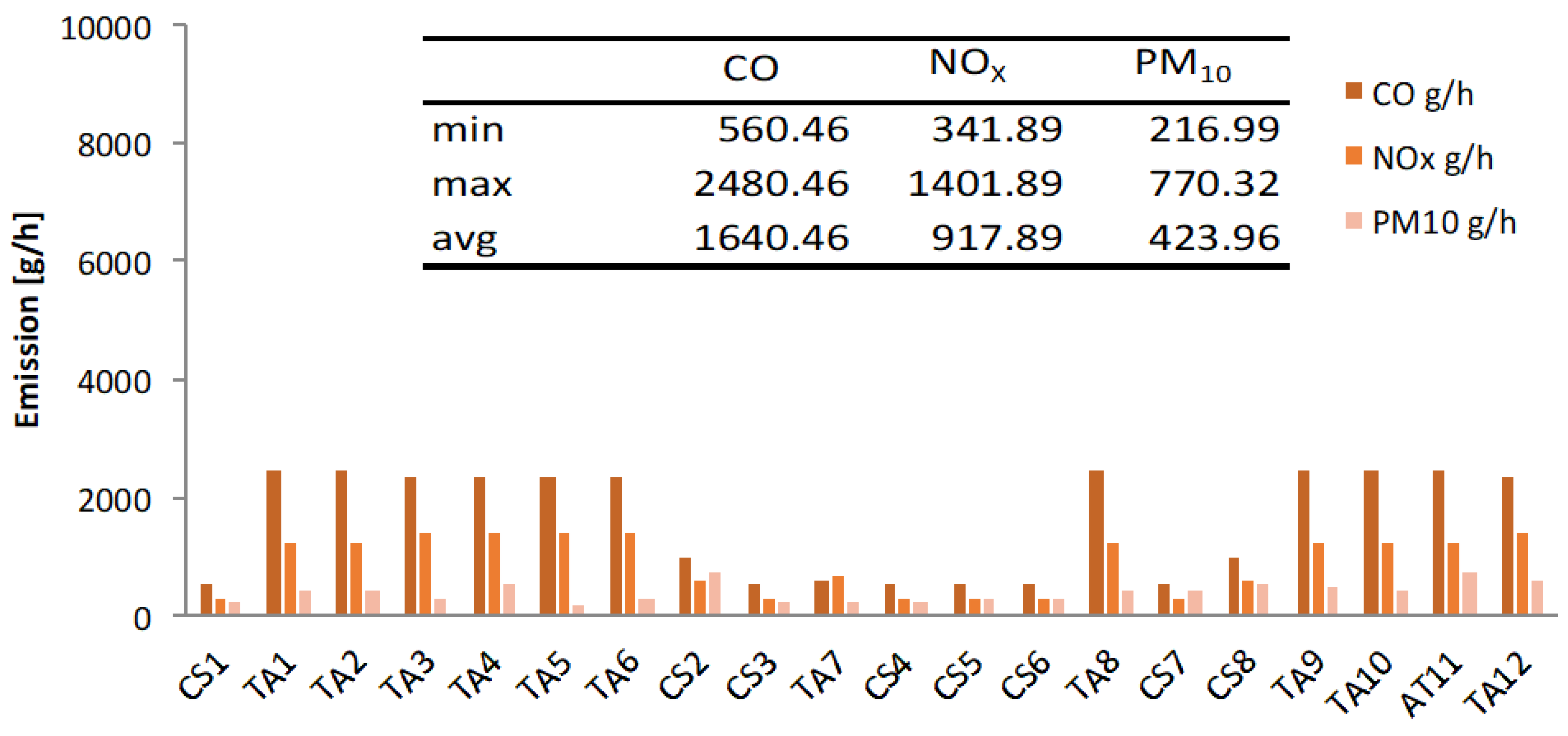
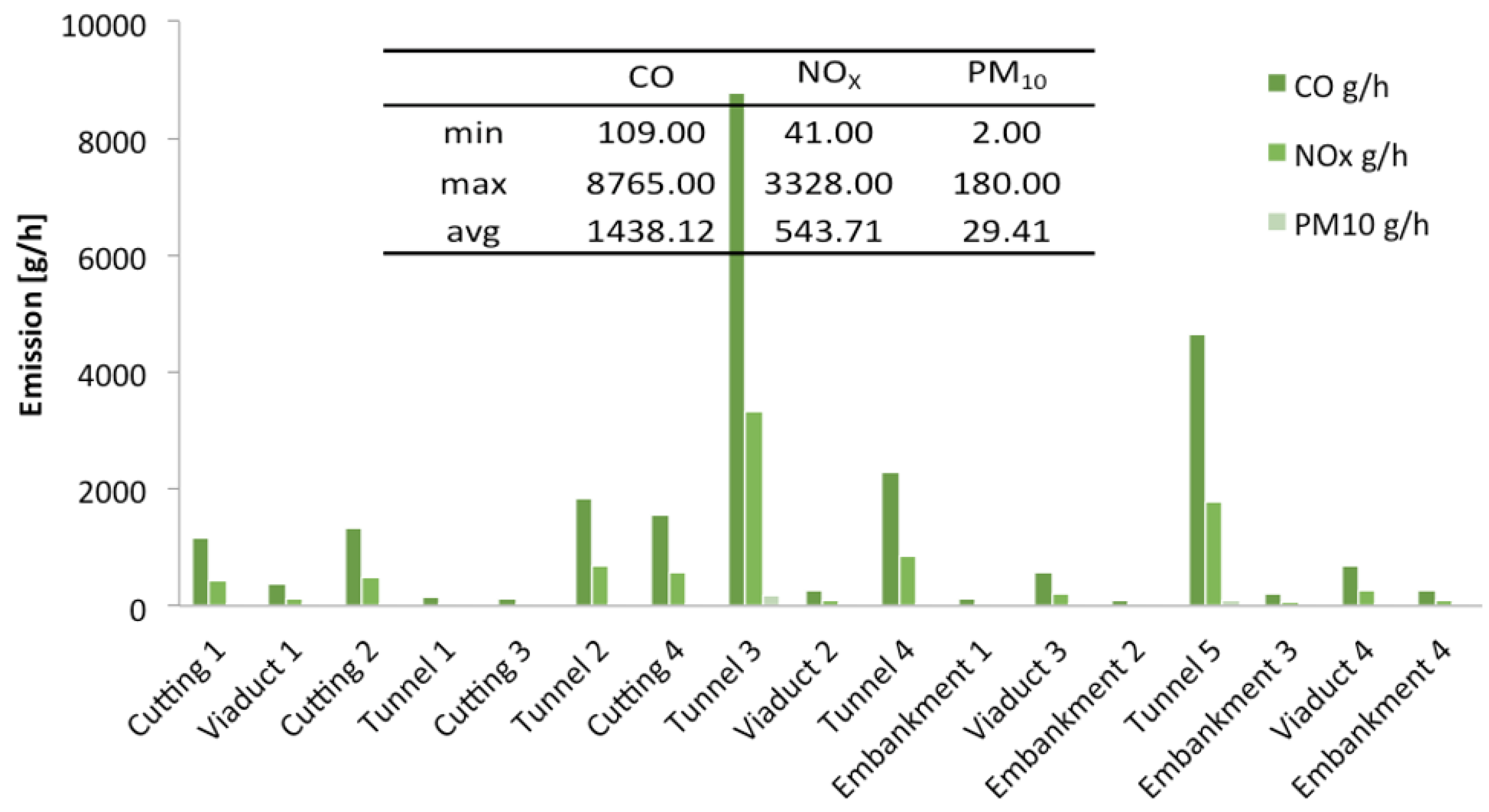
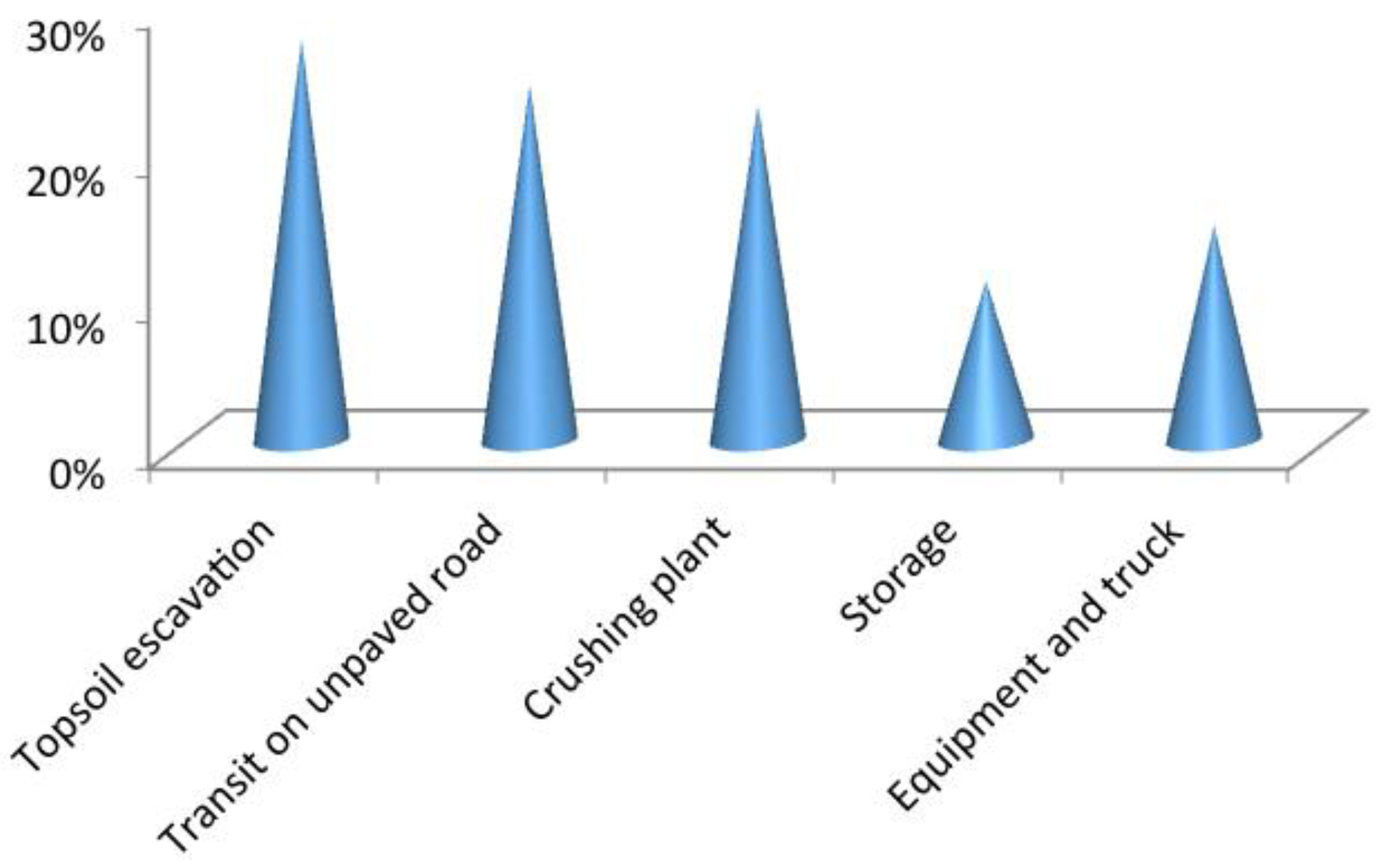
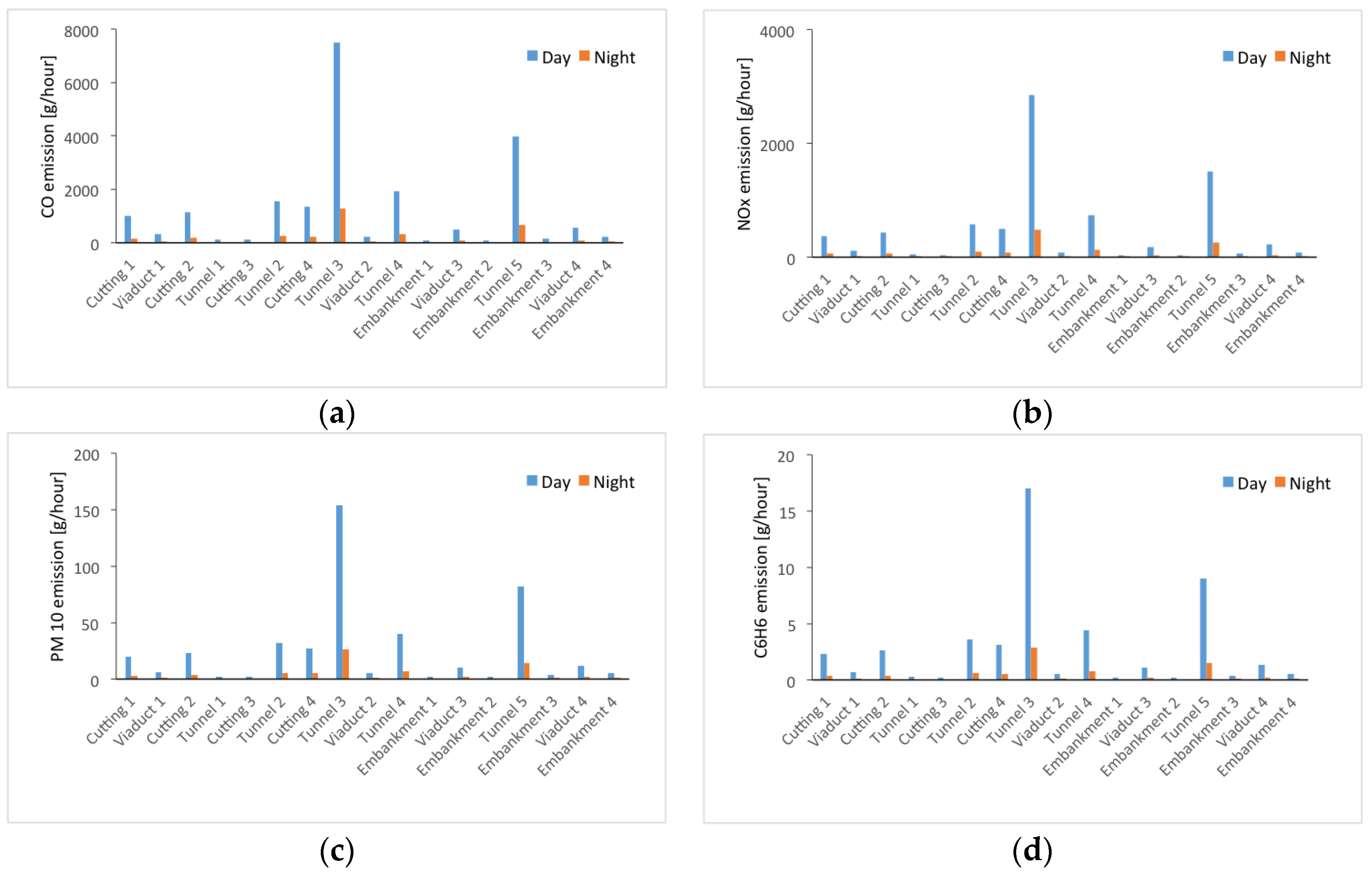
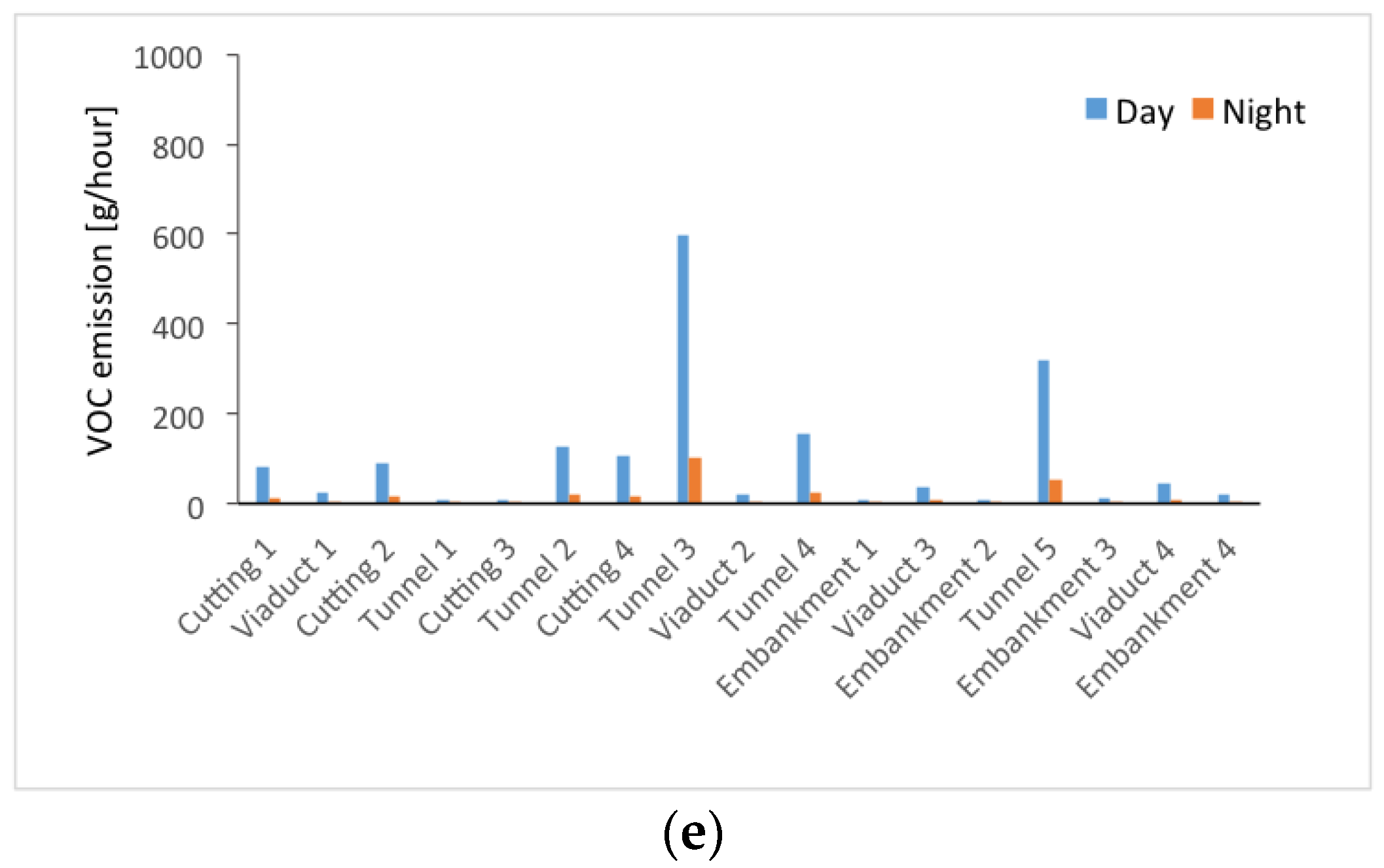

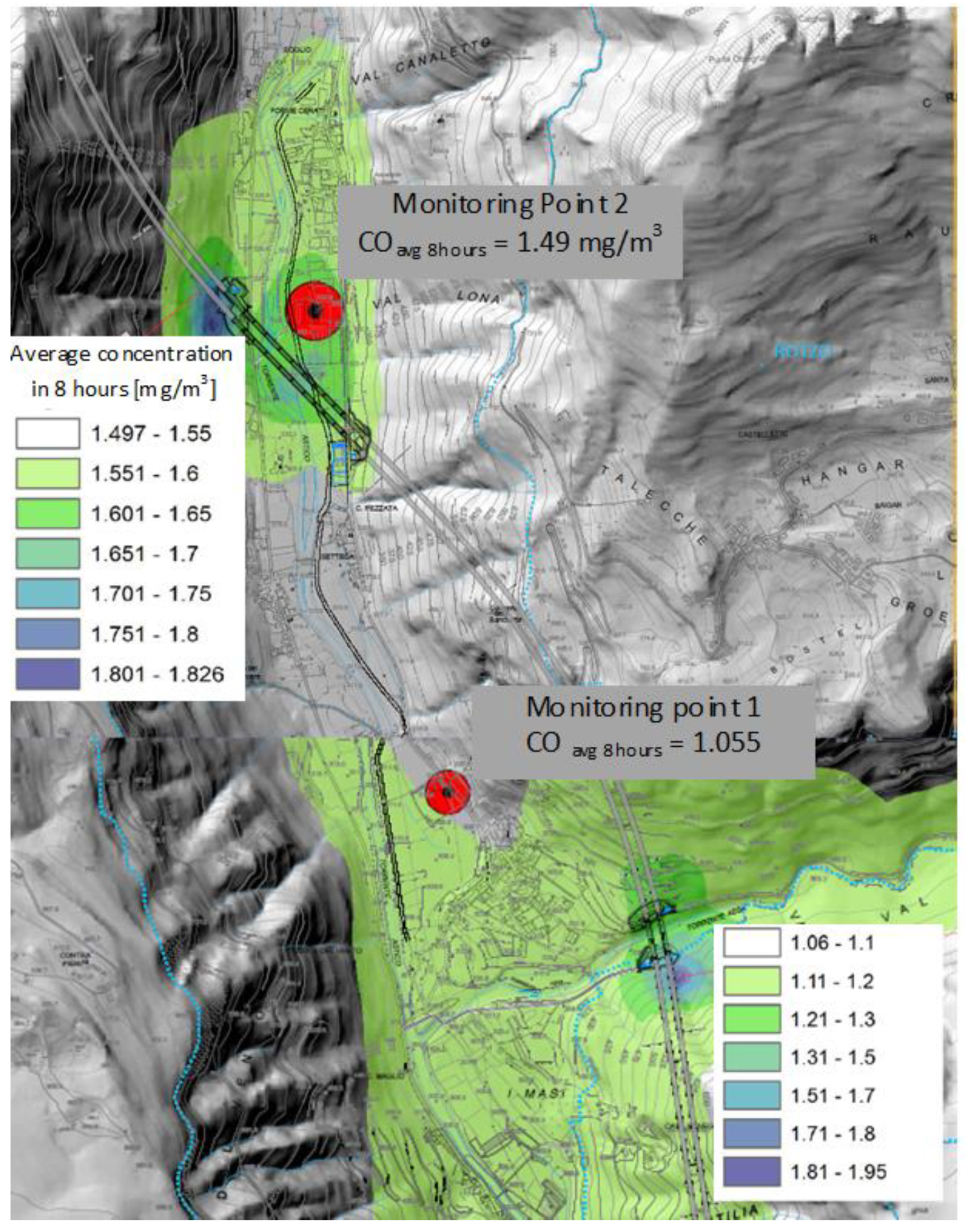
| Worksite | Equipment |
|---|---|
| CS1, CS3, CS4, CS5, CS6, CS7, TA13 | 2 Rubber-tired loaders 2 Trucks |
| TA1, TA2, TA8 | 4 Drilling machines 2 Excavators 2 Rubber-tired loaders 2 Cement mixers 2 Trucks |
| TA3, TA4, TA5, TA6, TA9, TA10, TA11, TA12 | 2 Excavators 2 Rubber-tired loaders 2 Graders 2 Roller compactors 2 Trucks |
| CS2, CS8 | 2 Rubber-tired loaders 1 Crushing plant 1 Concrete plant 2 Trucks |
| TA7 | 1 Rubber-tired loader 1 Crane 1 Conveyor belt 2 Trucks |
| Peak Hour Flow (Vehicle/Hour) | Heavy Vehicle (%) | ||
|---|---|---|---|
| Day | Night | ||
| Section 1 (0+000–4+500) | 910 | 154 | 26.3 |
| Section 2 (5+000–18+000) | 867 | 147 | 27.1 |
| Equipment | Emission Factor kg/h | ||
|---|---|---|---|
| CO | NOx | PM10 | |
| Drilling machine | 0.16 | 0.05 | 0.01 |
| Excavator | 0.30 | 0.13 | 0.01 |
| Rubber Tired Loaders | 0.28 | 0.17 | 0.01 |
| Cement mixer | 0.34 | 0.21 | 0.01 |
| Grader | 0.33 | 0.20 | 0.01 |
| Roller compactor | 0.28 | 0.20 | 0.01 |
| Concrete plant | 0.03 | 0.06 | 0.01 |
| Crushing plant | 0.43 | 0.25 | 0.01 |
| Crane | 0.17 | 0.26 | 0.01 |
| Conveyor belt | 0.17 | 0.23 | 0.01 |
| Emission factor g/km·vehicle | |||
| Trucks | 1.15 | 4.72 | 0.17 |
| Activity | Model | Reference |
|---|---|---|
| Transits onunpaved road | E = specific emission factor [kg/h] k = 1.5, multiplier factor s = content of silt (%) W = average vehicle weight (tons), a and b = coefficients | [33] |
| Topsoil excavation | E = 3.42 [kg/km] | [33] |
| Storage | Heap formation E = PM10 emission factor (kg /tons removed material) U = Average wind speed M = soil moisture content in % k = multiplicative factor Loading E = 6.8 [kg/tons] Discharge E = 0.45 [kg/tons] | [33] |
| Aggregate crushing | Truck downloading E = 0.000008 [kg/tons] Secondary crushing E = 0.000370 [kg/tons] Tertiary crushing E = 0.000270 [kg/tons] Screening E = 0.000370 [kg/tons] | [35] |
| Year | CO | NOx | PM10 | ||
|---|---|---|---|---|---|
| Gasoline | Diesel | Gasoline | Diesel | Diesel | |
| 2010 | 1 | 1 | 1 | 1 | 1 |
| 2015 | 0.75 | 0.74 | 0.65 | 0.76 | 0.55 |
| 2030 | 0.40 | 0.57 | 0.22 | 0.35 | 0.13 |
| 2015–2030 | 0.53 | 0.77 | 0.34 | 0.46 | 0.24 |
| Year | CO 2030 g/km h | NOx 2030 g/km h | PM10 2030 g/km h |
|---|---|---|---|
| Passenger cars | 0.576 | 0.050 | 0.005 |
| Heavy Duty Trucks | 0.894 | 0.260 | 0.038 |
| Length (km) | CO (g/h) | NOx (g/h) | PM10 (g/h) | ||||
|---|---|---|---|---|---|---|---|
| Day | Night | Day | Night | Day | Night | ||
| Cutting 1 | 0.84 | 1006 | 170 | 375 | 64 | 20 | 3 |
| Viaduct 1 | 0.26 | 314 | 53 | 117 | 20 | 6 | 1 |
| Cutting 2 | 0.95 | 1141 | 193 | 426 | 72 | 23 | 4 |
| Tunnel 1 | 0.10 | 120 | 20 | 45 | 8 | 2 | 0 |
| Cutting 3 | 0.09 | 105 | 18 | 39 | 7 | 2 | 0 |
| Tunnel 2 | 1.31 | 1568 | 265 | 585 | 99 | 32 | 5 |
| Cutting 4 | 1.11 | 1338 | 226 | 499 | 84 | 27 | 5 |
| Tunnel 3 | 6.53 | 7494 | 1271 | 2846 | 482 | 154 | 26 |
| Viaduct 2 | 0.20 | 231 | 39 | 88 | 15 | 5 | 1 |
| Tunnel 4 | 1.70 | 1948 | 330 | 740 | 125 | 40 | 7 |
| Embankment 1 | 0.09 | 102 | 17 | 39 | 7 | 2 | 0 |
| Viaduct 3 | 0.42 | 484 | 82 | 184 | 31 | 10 | 2 |
| Embankment 2 | 0.08 | 93 | 16 | 35 | 6 | 2 | 0 |
| Tunnel 5 | 3.47 | 3984 | 675 | 1513 | 256 | 82 | 14 |
| Embankment 3 | 0.15 | 170 | 29 | 65 | 11 | 4 | 1 |
| Viaduct 4 | 0.50 | 575 | 98 | 219 | 37 | 12 | 2 |
| Embankment 4 | 0.20 | 233 | 40 | 89 | 15 | 5 | 1 |
| Section | Area [m2] | Elevation [m] | CO Flow [g/s/m2] | |
|---|---|---|---|---|
| Day (6–22) | Night (22–6) | |||
| Viaduct 2 | 6062 | 352 | 1.06 × 10−5 | 1.80 × 10−5 |
| Embankment 1 | 2663 | 331 | 1.06 × 10−5 | 1.80 × 10−5 |
| Viaduct 2 | 12,659 | 332 | 1.06 × 10−5 | 1.80 × 10−5 |
| Embankment 2 | 2441 | 335 | 1.06 × 10−5 | 1.80 × 10−5 |
| Section | Height [m2] | Elevation [m] | CO Flow [g/s] | |
|---|---|---|---|---|
| Day (6–22) | Night (22–6) | |||
| Tunnel 3 | 4 | 352 | 1.04 | 1.76 × 10−1 |
| Tunnel 4 (portal south) | 3 | 351 | 2.71 × 10−1 | 4.59 × 10−2 |
| Tunnel 4 (portal north) | 3 | 331 | 2.71 × 10−1 | 4.59 × 10−2 |
| Tunnel 5 | 4 | 335 | 5.53 × 10−1 | 9.38 × 10−2 |
Publisher’s Note: MDPI stays neutral with regard to jurisdictional claims in published maps and institutional affiliations. |
© 2020 by the author. Licensee MDPI, Basel, Switzerland. This article is an open access article distributed under the terms and conditions of the Creative Commons Attribution (CC BY) license (http://creativecommons.org/licenses/by/4.0/).
Share and Cite
Giunta, M. Assessment of the Impact of CO, NOx and PM10 on Air Quality during Road Construction and Operation Phases. Sustainability 2020, 12, 10549. https://doi.org/10.3390/su122410549
Giunta M. Assessment of the Impact of CO, NOx and PM10 on Air Quality during Road Construction and Operation Phases. Sustainability. 2020; 12(24):10549. https://doi.org/10.3390/su122410549
Chicago/Turabian StyleGiunta, Marinella. 2020. "Assessment of the Impact of CO, NOx and PM10 on Air Quality during Road Construction and Operation Phases" Sustainability 12, no. 24: 10549. https://doi.org/10.3390/su122410549





